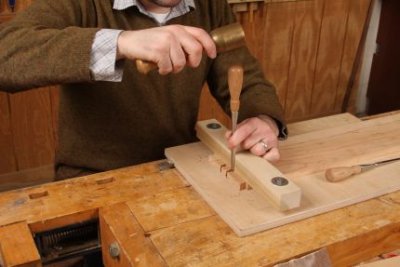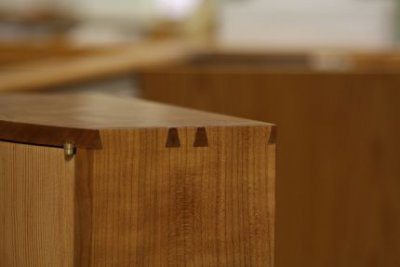Een prachtig verhaal, nu een keer eerst de foto's en dan de tekst.
jaap


Before you go any farther with this blog post, take a moment and look at the photo of some dovetails I cut for a bow front wall cabinet I made in the fall. How do you think I cut them? Do you even care? Would your opinion of them (and the cabinet) change if you knew that I had cut them with machines? Completely by hand? By some combination of the two?
Here's why I'm asking these questions. This past weekend, I attended a Lie-Nielsen Hand Tool Event in Brooklyn, NY, talking to fellow handtool freaks, handing out copies of the magazine, and demonstrating how I use handtools in my work. At one point on Saturday I was cleaning out the waste between some tails. The board was clamped into the jig you see in the second photo above. The fence on the jig holds the board in place and also aligns with the joint's baseline. So, it does double duty as a paring guide. It guarantees a baseline that's straight across the board, square to the edge, and also square to the face of the board. While I'm paring away, another woodworker walks up and says, "That's cheating." And I responded, "No. It's not." There wasn't much more of an exchange, but when he had walked away, I turned to the other folks standing around and said, "There's no such thing as cheating in woodworking. And don't let anyone tell you there is."
We've all heard that "argument" before: If you use some kind of jig or aid to improve your joinery (especially if it's a dovetail), then you're somehow taking an unfair shortcut. By extension, it's implied that you're not as good or authentic a woodworker as those who don't rely on the jig. That line of thinking is complete hogwash. Here's why.
What matters when you're making furniture is the furniture. When all the tools are put away and the finish is dry, have you made a beautiful piece of furniture that you and other folks find beautiful and useful? If so, then nothing else matters. So, do whatever it takes to make the furniture you love, even if that means using a router, tablesaw, or a chisel guide to cut dovetails. Heck, do it even if it means leaving behind traditional furniture making techniques and joints (like the dovetail). Try as many techiques as you can and find the one that works best for you (efficient and produces great results). And don't worry about whether or not the technique is cheating, just worry about whether or not the furniture you make is beautiful.
One last point. I didn't write this blog because my feelings were hurt. They weren't. I'm writing it because I wanted to counter a poisonous attitude that can belittle and defeat those of us who are just starting out and trying to l learn the craft. We need to encourage those folks, not deter them.
jaap


Before you go any farther with this blog post, take a moment and look at the photo of some dovetails I cut for a bow front wall cabinet I made in the fall. How do you think I cut them? Do you even care? Would your opinion of them (and the cabinet) change if you knew that I had cut them with machines? Completely by hand? By some combination of the two?
Here's why I'm asking these questions. This past weekend, I attended a Lie-Nielsen Hand Tool Event in Brooklyn, NY, talking to fellow handtool freaks, handing out copies of the magazine, and demonstrating how I use handtools in my work. At one point on Saturday I was cleaning out the waste between some tails. The board was clamped into the jig you see in the second photo above. The fence on the jig holds the board in place and also aligns with the joint's baseline. So, it does double duty as a paring guide. It guarantees a baseline that's straight across the board, square to the edge, and also square to the face of the board. While I'm paring away, another woodworker walks up and says, "That's cheating." And I responded, "No. It's not." There wasn't much more of an exchange, but when he had walked away, I turned to the other folks standing around and said, "There's no such thing as cheating in woodworking. And don't let anyone tell you there is."
We've all heard that "argument" before: If you use some kind of jig or aid to improve your joinery (especially if it's a dovetail), then you're somehow taking an unfair shortcut. By extension, it's implied that you're not as good or authentic a woodworker as those who don't rely on the jig. That line of thinking is complete hogwash. Here's why.
What matters when you're making furniture is the furniture. When all the tools are put away and the finish is dry, have you made a beautiful piece of furniture that you and other folks find beautiful and useful? If so, then nothing else matters. So, do whatever it takes to make the furniture you love, even if that means using a router, tablesaw, or a chisel guide to cut dovetails. Heck, do it even if it means leaving behind traditional furniture making techniques and joints (like the dovetail). Try as many techiques as you can and find the one that works best for you (efficient and produces great results). And don't worry about whether or not the technique is cheating, just worry about whether or not the furniture you make is beautiful.
One last point. I didn't write this blog because my feelings were hurt. They weren't. I'm writing it because I wanted to counter a poisonous attitude that can belittle and defeat those of us who are just starting out and trying to l learn the craft. We need to encourage those folks, not deter them.

